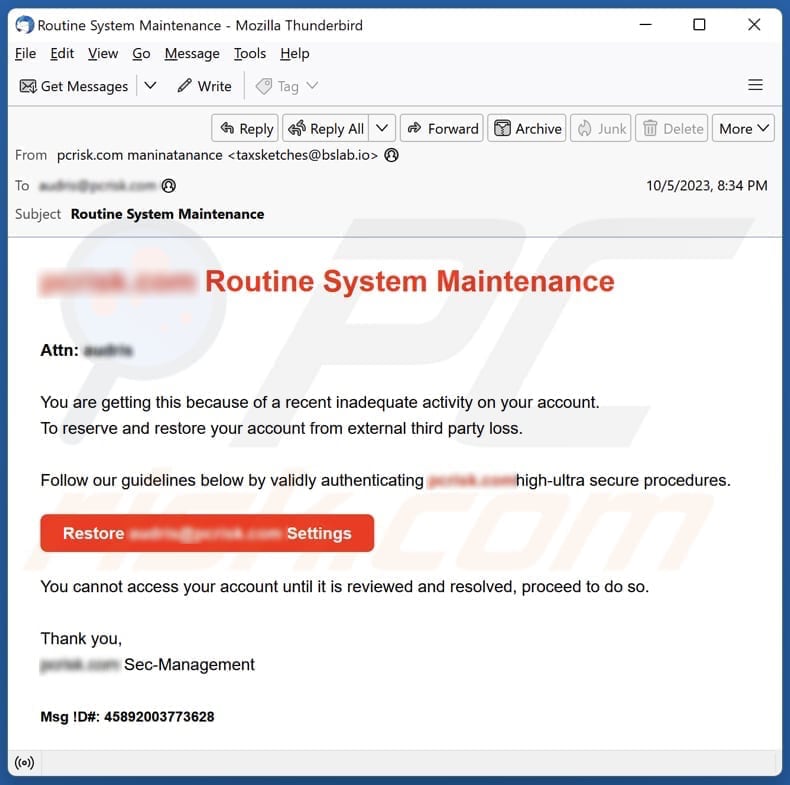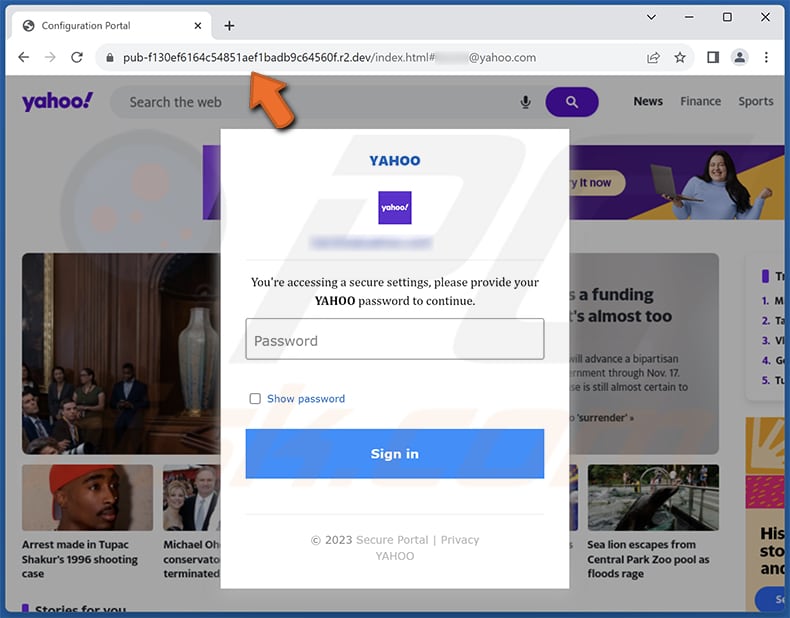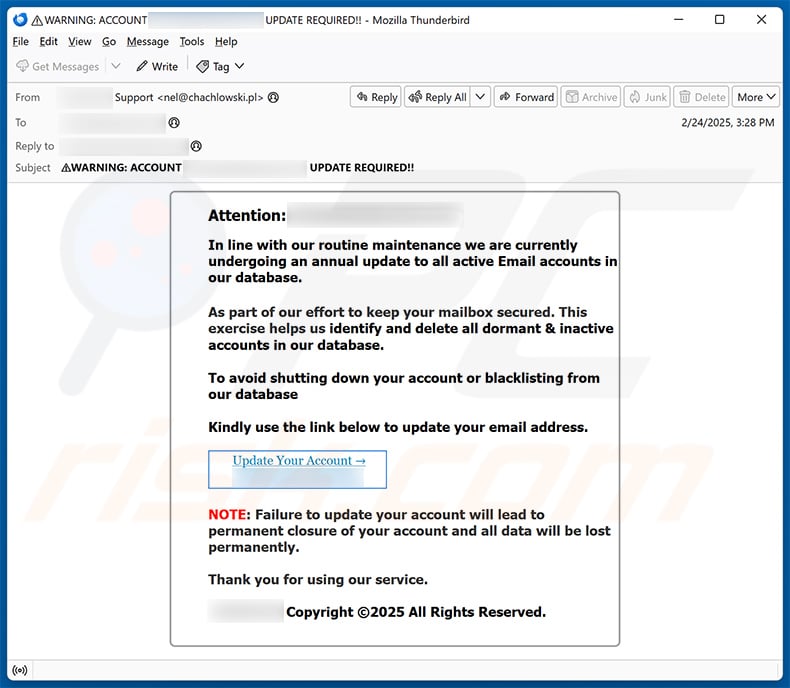How to avoid falling for emails like "Routine System Maintenance"
Phishing/ScamAlso Known As: Routine System Maintenance phishing scam
Get free scan and check if your device is infected.
Remove it nowTo use full-featured product, you have to purchase a license for Combo Cleaner. Seven days free trial available. Combo Cleaner is owned and operated by RCS LT, the parent company of PCRisk.com.
What is "Routine System Maintenance"?
After careful examination, it has been verified that this email constitutes a phishing scam. The perpetrators behind this fraudulent campaign seek to deceive recipients into disclosing sensitive information on a fake page. Consequently, it is highly advised to disregard this email.

More about the "Routine System Maintenance" scam email
The phishing email, disguised as a routine system maintenance notice, is directed towards its recipient under the pretext of addressing recent suspicious activity on their account. It urges the recipient to engage in a purported account restoration process to safeguard against potential third-party breaches.
The email claims to provide high-security measures but lacks specific details. The deceptive message insists that the recipient needs to restore their account settings to regain access, emphasizing that their account remains inaccessible until the suggested steps are taken.
The message is signed as being from the "Sec-Management" of the recipient's service provider, further attempting to lend an air of legitimacy to the fraudulent communication. It contains a button labelled "Restore (recipient's email address) Settings) designed to open a phishing website.
The phishing page imitates the appearance of the official email service provider's sign-in page, adjusting its design to match the recipient's specific email address. For instance, if a recipient uses Yahoo Mail, they will encounter a deceptive page that looks like the genuine Yahoo Mail sign-in site.
This mimicry is meant to trick users into entering their login credentials (email addresses and passwords on a fake website. Scammers can employ stolen email account login credentials in various detrimental ways.
First and foremost, they gain unauthorized access to the victim's email account, providing them with personal and sensitive information. This includes access to emails, contacts, and potentially even stored documents, which can be exploited for identity theft, financial fraud, or blackmail.
Additionally, scammers can use the compromised email account as a launching pad for phishing attacks. They can send malicious emails to the victim's contacts, often leveraging the trust inherent in the victim's address book to deceive others into falling for their scams.
The victim's compromised account can be employed to propagate a wide range of malicious activities, including spreading malware, soliciting fraudulent payments, or perpetrating advance-fee fraud. Moreover, scammers might attempt to reset passwords for other online accounts associated with the victim's email address.
This potentially allows them to gain access to a multitude of accounts, including those linked to banking, social media, e-commerce, and more. Ultimately, stolen email credentials are highly valuable on the dark web, where they can be sold to other cybercriminals.
| Name | Routine System Maintenance Email Scam |
| Threat Type | Phishing, Scam, Social Engineering, Fraud |
| Fake Claim | Suspicious activity in the recipient's account has been detected |
| Disguise | Routine system maintenance notice |
| Symptoms | Unauthorized online purchases, changed online account passwords, identity theft, illegal access of the computer. |
| Distribution methods | Deceptive emails, rogue online pop-up ads, search engine poisoning techniques, misspelled domains. |
| Damage | Loss of sensitive private information, monetary loss, identity theft. |
| Malware Removal (Windows) |
To eliminate possible malware infections, scan your computer with legitimate antivirus software. Our security researchers recommend using Combo Cleaner. Download Combo CleanerTo use full-featured product, you have to purchase a license for Combo Cleaner. 7 days free trial available. Combo Cleaner is owned and operated by RCS LT, the parent company of PCRisk.com. |
Similar emails in general
Phishing emails are fraudulent messages designed to deceive recipients into divulging sensitive information like passwords, financial data, or other personal details. These deceptive emails typically impersonate reputable organizations or companies, employing tactics that create a sense of urgency to compel immediate responses.
They may contain links to malicious websites or attachments with malware, posing substantial security threats. Examples of phishing campaigns delivered via email are "Chan & Zuckerberg Initiative (CZI)", "Account And Service(s) Scheduled For Deletion", and "HR Department Shared A File With You".
How do spam campaigns infect computers?
Recipients may inadvertently compromise their computer's security through email in multiple ways. Opening email attachments is one avenue that can introduce malware to the system, jeopardizing its integrity. Enabling macros in email attachments presents another potential infection point.
Additionally, clicking on malicious links within emails can redirect users to harmful websites, facilitating the infiltration of malware into the system.
How to avoid installation of malware?
Exercise caution when dealing with email attachments and links, particularly in cases where the sender is unfamiliar, or the email raises suspicions. Avoid interactions with advertisements originating from unverified sources, and be cautious about visiting questionable websites.
Fostering computer security also involves keeping your system up-to-date, including the operating system, applications, and web browsers. Additionally, to ensure the integrity of your downloads, it is essential to rely exclusively on trustworthy sources like official websites and reputable app stores.
If you have already opened malicious attachments, we recommend running a scan with Combo Cleaner Antivirus for Windows to automatically eliminate infiltrated malware.
Text presented in the "Routine System Maintenance" email letter:
Subject: Routine System Maintenance
********* Routine System Maintenance
Attn: *********You are getting this because of a recent inadequate activity on your account.
To reserve and restore your account from external third party loss.Follow our guidelines below by validly authenticating *********high-ultra secure procedures.
Restore ********* Settings
You cannot access your account until it is reviewed and resolved, proceed to do so.Thank you,
********* Sec-ManagementMsg !D#: 45892003773628
Phishing website promoted via this email:

Another example of routine maintenance-themed spam email promoting a phishing site:

Text presented within:
Subject: WARNING: ACCOUNT "********" UPDATE REQUIRED!!
Attention: ********,
In line with our routine maintenance we are currently undergoing an annual update to all active Email accounts in our database.
As part of our effort to keep your mailbox secured. This exercise helps us identify and delete all dormant & inactive accounts in our database.To avoid shutting down your account or blacklisting from our database
Kindly use the link below to update your email address.
Update Your Account ********
NOTE: Failure to update your account will lead to permanent closure of your account and all data will be lost permanently.
Thank you for using our service.
******** Copyright ©2025 All Rights Reserved.
Instant automatic malware removal:
Manual threat removal might be a lengthy and complicated process that requires advanced IT skills. Combo Cleaner is a professional automatic malware removal tool that is recommended to get rid of malware. Download it by clicking the button below:
DOWNLOAD Combo CleanerBy downloading any software listed on this website you agree to our Privacy Policy and Terms of Use. To use full-featured product, you have to purchase a license for Combo Cleaner. 7 days free trial available. Combo Cleaner is owned and operated by RCS LT, the parent company of PCRisk.com.
Quick menu:
- What is Routine System Maintenance phishing scam?
- Types of malicious emails.
- How to spot a malicious email?
- What to do if you fell for an email scam?
Types of malicious emails:
![]() Phishing Emails
Phishing Emails
Most commonly, cybercriminals use deceptive emails to trick Internet users into giving away their sensitive private information, for example, login information for various online services, email accounts, or online banking information.
Such attacks are called phishing. In a phishing attack, cybercriminals usually send an email message with some popular service logo (for example, Microsoft, DHL, Amazon, Netflix), create urgency (wrong shipping address, expired password, etc.), and place a link which they hope their potential victims will click on.
After clicking the link presented in such email message, victims are redirected to a fake website that looks identical or extremely similar to the original one. Victims are then asked to enter their password, credit card details, or some other information that gets stolen by cybercriminals.
![]() Emails with Malicious Attachments
Emails with Malicious Attachments
Another popular attack vector is email spam with malicious attachments that infect users' computers with malware. Malicious attachments usually carry trojans that are capable of stealing passwords, banking information, and other sensitive information.
In such attacks, cybercriminals' main goal is to trick their potential victims into opening an infected email attachment. To achieve this goal, email messages usually talk about recently received invoices, faxes, or voice messages.
If a potential victim falls for the lure and opens the attachment, their computers get infected, and cybercriminals can collect a lot of sensitive information.
While it's a more complicated method to steal personal information (spam filters and antivirus programs usually detect such attempts), if successful, cybercriminals can get a much wider array of data and can collect information for a long period of time.
![]() Sextortion Emails
Sextortion Emails
This is a type of phishing. In this case, users receive an email claiming that a cybercriminal could access the webcam of the potential victim and has a video recording of one's masturbation.
To get rid of the video, victims are asked to pay a ransom (usually using Bitcoin or another cryptocurrency). Nevertheless, all of these claims are false - users who receive such emails should ignore and delete them.
How to spot a malicious email?
While cyber criminals try to make their lure emails look trustworthy, here are some things that you should look for when trying to spot a phishing email:
- Check the sender's ("from") email address: Hover your mouse over the "from" address and check if it's legitimate. For example, if you received an email from Microsoft, be sure to check if the email address is @microsoft.com and not something suspicious like @m1crosoft.com, @microsfot.com, @account-security-noreply.com, etc.
- Check for generic greetings: If the greeting in the email is "Dear user", "Dear @youremail.com", "Dear valued customer", this should raise suspiciousness. Most commonly, companies call you by your name. Lack of this information could signal a phishing attempt.
- Check the links in the email: Hover your mouse over the link presented in the email, if the link that appears seems suspicious, don't click it. For example, if you received an email from Microsoft and the link in the email shows that it will go to firebasestorage.googleapis.com/v0... you shouldn't trust it. It's best not to click any links in the emails but to visit the company website that sent you the email in the first place.
- Don't blindly trust email attachments: Most commonly, legitimate companies will ask you to log in to their website and to view any documents there; if you received an email with an attachment, it's a good idea to scan it with an antivirus application. Infected email attachments are a common attack vector used by cybercriminals.
To minimise the risk of opening phishing and malicious emails we recommend using Combo Cleaner Antivirus for Windows.
Example of a spam email:

What to do if you fell for an email scam?
- If you clicked on a link in a phishing email and entered your password - be sure to change your password as soon as possible. Usually, cybercriminals collect stolen credentials and then sell them to other groups that use them for malicious purposes. If you change your password in a timely manner, there's a chance that criminals won't have enough time to do any damage.
- If you entered your credit card information - contact your bank as soon as possible and explain the situation. There's a good chance that you will need to cancel your compromised credit card and get a new one.
- If you see any signs of identity theft - you should immediately contact the Federal Trade Commission. This institution will collect information about your situation and create a personal recovery plan.
- If you opened a malicious attachment - your computer is probably infected, you should scan it with a reputable antivirus application. For this purpose, we recommend using Combo Cleaner Antivirus for Windows.
- Help other Internet users - report phishing emails to Anti-Phishing Working Group, FBI’s Internet Crime Complaint Center, National Fraud Information Center and U.S. Department of Justice.
Frequently Asked Questions (FAQ)
Why did I receive this email?
Scammers send identical messages to a broad audience with the hope that at least one recipient will fall for their scheme. These spam emails typically lack personalization and display a markedly generic character.
I have provided my personal information when tricked by this email, what should I do?
In the event that scammers have unlawfully obtained your email account credentials, it is of paramount importance to take immediate action. Initiate the process by changing the passwords for any accounts where you have utilized the stolen login information. Additionally, report the security breach to your email service provider.
I have downloaded and opened a malicious file attached to an email, is my computer infected?
The risk of infection significantly rises when handling executable files (like .exe). On the other hand, with file formats like .pdf or .doc, there is a chance that opening these documents may not result in an infection, as certain types of malware may lack the capability to compromise computers without additional interaction.
I have read the email but did not open the attachment, is my computer infected?
Merely opening an email is generally regarded as a safe action, as it does not inherently expose the user to immediate risks. The potential for system infections arises after clicking on embedded links or opening attached files.
Will Combo Cleaner remove malware infections that were present in email attachment?
Combo Cleaner has the capability to eliminate most known malware. However, advanced malware can conceal itself deeply within the system. Therefore, it is recommended to conduct a full system scan to ensure the detection and removal of hidden threats.
Share:

Tomas Meskauskas
Expert security researcher, professional malware analyst
I am passionate about computer security and technology. I have an experience of over 10 years working in various companies related to computer technical issue solving and Internet security. I have been working as an author and editor for pcrisk.com since 2010. Follow me on Twitter and LinkedIn to stay informed about the latest online security threats.
PCrisk security portal is brought by a company RCS LT.
Joined forces of security researchers help educate computer users about the latest online security threats. More information about the company RCS LT.
Our malware removal guides are free. However, if you want to support us you can send us a donation.
DonatePCrisk security portal is brought by a company RCS LT.
Joined forces of security researchers help educate computer users about the latest online security threats. More information about the company RCS LT.
Our malware removal guides are free. However, if you want to support us you can send us a donation.
Donate
▼ Show Discussion